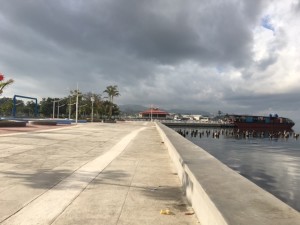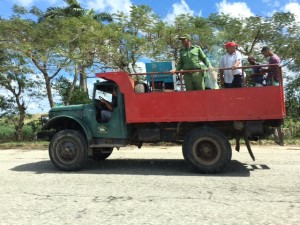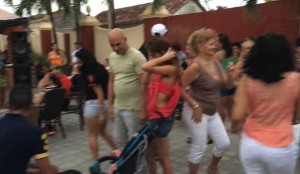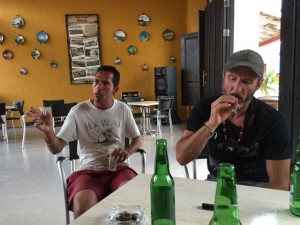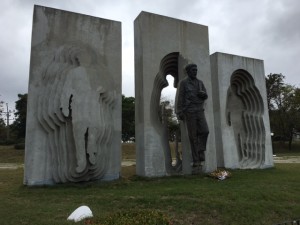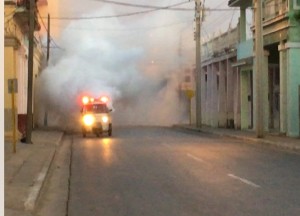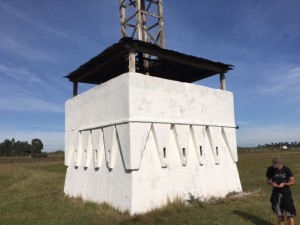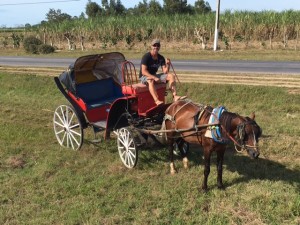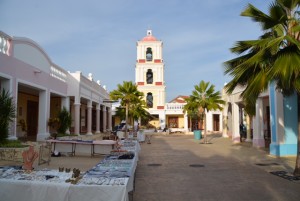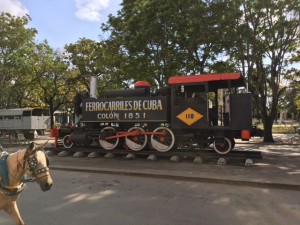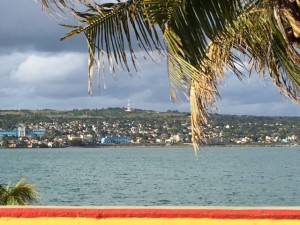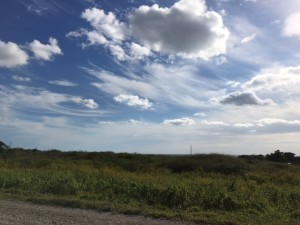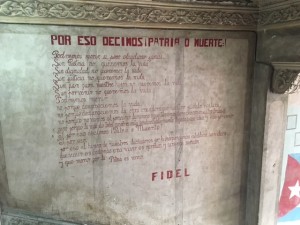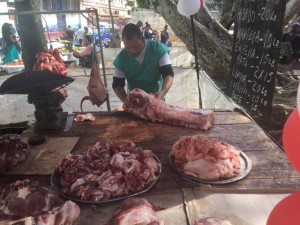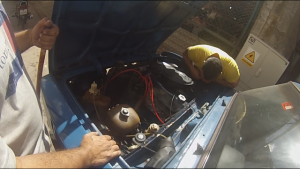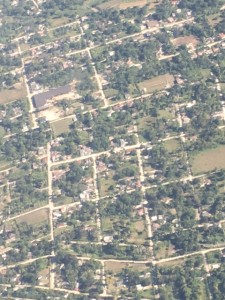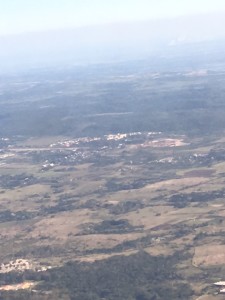A short stroll through the square and down the hill to the waterfront revealed clean streets surrounded by rougher buildings than previously seen in Cuban cities. Against the polluted water was a tidy area. A woman was sweeping the promenade with what looked like a witch’s broom.
After a good breakfast and a dose of Wi-Fi at the square we drove around the waterfront and through some less than tidy suburbs before heading north. At one point Miguel stopped and pointed out a park where the locals had gathered and slept during a recent earthquake.
There is a modern highway heading out of town, but like most roads it is full of potholes. Although it’s left hand drive here Miguel drives on both sides of the road to try and preserve this almost new, badly made, Chinese car. We turn off the motorway heading up through mainly sugar plantations. Stopping on a bridge in the Milla province we witness guys in large rubber tyre tubes casting nets and catching fish in the lake.
People ride the backs of large trucks while others are stacked into what can only be described as truck buses.
We stopped along the way and brought some rather greasy sausages which were hanging an string over a half 44 gallon drum bbq. We tried to buy water at the stall next door but, as with the petrol stations we had stopped at for the same purpose, plenty of rum and beer but no water.
We drove through Holgiun onto the seaside town of Gibara. The town was ravaged by the 2008 hurricanes. Many buildings have since been restored including two brightly coloured up market hotels.
At a local bar Cam, now in his pink shorts, was befriended by a local chap called Mani, an expert in cigars and many other things – he claimed. He took us to a local outdoor music bar. A pretty good bunch of musicians entertained a crowd of locals, from kids in push chairs to grandparents. Cam’s new-found friend had by this stage finished his bottle of rum. Yes you guessed it! He needed money for another one; the friendship was terminated.
We dined at Villa Caney, our Casa. All the Casas we have stayed at so far have been clean and well done up with tiled bathrooms and bright furnishings. This one also has its own restaurant. The food was amazing with Dari, a keen enthusiastic waitress, who ran all the tables on her own. She was back to serve us breakfast at 8am
Monday 8 February
A morning stroll up the hill revealed an area of dirt streets and shacks. Houses, some like huts, have wooden shutters instead of steel; streets are dirt and the houses small. A lady wheels a cart full of bread along the dirt road as locals come out and stock up. The highest point on the hill is occupied by a decaying Spanish fort. A large textile factory is set further back on the hill.
An old man stands at the dirt intersection swaying as he grasps tightly on to his bottle of rum; another lies on the ground with his hand out and an empty rum bottle leans on his leg. Here in Gibara is the first time we have seen people looking intoxicated. Last night at the event apart from Cam’s friend Mani a few others were looking a bit worse for wear.
After breakfast we headed west a short distance towards a beach some ten plus kms away. The shingle road was just too much for the cheap BYD car so we had to turn back
In Holguin we stopped to get a service done on the car. Just down the road was a statue to Che Guevara. This man must be the most painted and carved in stone guy in the country. He also figures on t-shirts, hats, flags and many more items. Castro is a long way behind him. All the heroes of the revolution are remembered all over the place. Slogans are printed on bill boards and other places. The only other place I have seen so much indoctrination type material is Hanoi in Vietnam.
We stopped in Las Tunas for a drink and sat in the park to get some Wi-Fi. Heading west along the road we had travelled on a few days earlier there is little new to report. We reached Ceigo de Avila just after five where we settled in for the night. This is one of the less attractive cities we have been to with few bars and restaurants.
While strolling down a street close to the main square a siren sparked up just down the road; huge clouds of what looked like smoke were filling the street. It looked like the fire engine was on fire.
Then the flashing lights started moving towards us. A large man ushered us into a restaurant and closed the doors, smoke billowing against the windows. “What was that?” we asked. “Just the mosquito spray machine”. Apparently this happens every couple of days.
A meal at a small restaurant for 2 locals each rounded off a long day over 300km of travel.
Tuesday 9 February
A stroll out to the north side of Ciego da Avilla, founded in the mid-eighteen-hundreds as a military town, revealed little we hadn’t seen before apart from a few small wooden houses, which are unusual in Cuba. After breakfast we hopped on a Colonial styled horse-drawn coach. Made of steel with car springs they looked the part from a distance. We headed out to look at the last remains of a seventy eight kilometre wall built by the Spaniards in the mid-eighteen-hundreds to divide the country and protect the affluent west from the rebels from the east. What we thought was just down the road turned out to be several kilometres away. The horse took it in his stride, at a trot both ways he never broke sweat. There was only a tower left of the wall built by slaves and cheap Chinese labour.
Next we headed to Sancti Spiritus where we went to a rather interesting house with the ceiling being held up by timber type scaffolding. There we did what may have been a dodgy deal on some Cuban Cohiba cigars. Lunch at La Dona restaurant close by was excellent at 7 locals each including beer.
We arrived at Caibarien about 4pm. This partly falling down town is situated on the northern coast and famous for its crabs; one day in the future may be a thriving tourist town. After booking into Hostal La Del Norte we took a drive out to Cayo Santa Maria. There is a causeway some twenty kilometres long to reach this string of islands which are now joined by a continuing causeway. They contain an airport and many resort type hotels. We took a stroll into one which had its own shopping centre, numerous blocks of units and a large swimming pool, beyond which is an amazing white sand blue water beach.
On return to the casa we were greeted with a meal of shrimps, lobster, crab, fish, rice and salad.
Wednesday 10 February
My morning stroll was through a mainly suburban area with mostly single-story houses. The odd two-story house had an external concrete spiral staircase.
A ditch with a trickle of black slimy water ran between the street and most houses; each ditch exited straight into the sea. Two fisherman poled what looked like a raft across the bay.
After breakfast we had a look at the local square where they are restoring some old buildings. Next we reached the close by town of Remedious. In the square we found a number of really well restored buildings, among them some of the nicest bars we have seen in Cuba. There were a number of tour buses in town and tourists wandered the shops and bars.
Heading west we came to Santa Clara where the tomb and largest monument to Che Guevara is. Apparently he won a great battle here which was instrumental in the overall victory for the revolution. Under the tomb is a small museum with a rather officious lady in her fishnet stockings exerting her authority. I had to wait outside while Cam and AJ went through as i was carrying a camera. She was insistent that my toes were behind the line as i waited. The museum covered his life – all in Spanish – with displays of his doctor days in Argentina to the end in Bolivia portrayed mainly in photos with a few weapons and copies of letters and other memorabilia. Above the tomb is a large statue, like most in Cuba rather crudely sculptured.
Heading west and then north we drove through large sugar cane plantations, many farms with pivot irrigation. We passed through many small towns where we presume a lot of the labour for the farms and mills came from. At the town of Colon there was a statue to Cristobal Colon (Christopher Columbus) and one of the many old steam engines on display around the country.
Around 4 pm we arrived in Mantanzas a costal city of around three hundred thousand people.
After settling into Hostal Italy we strolled the streets batting off gold-chained cigar and anything else you might want salesmen before eating at a local Italian restaurant.
Thursday 11 February
Leaving Mantanzas around 9 we took the coast road west to Havana. This turned out to be one of the most picturesque routes we have taken during our two thousand plus kilometres traveled over the last nine days. Not far out of town we were traveling along a ridge with the sea to our right and a large open valley to out left.
As we headed further west the coast became more industrialised with large oil fired power plants, oil refineries and a little later on a gas fired power plant. We think they have struck gas and some oil around here.
This was also one of the better roads with little swerving required to avoid potholes. A bit about driving in Cuba: Don’t worry too much if you see a car coming towards you on the wrong side of the road – it’s just avoiding potholes and will move over before it gets danger close. When passing, even when on a four or six lane road with medium strip!, always sound horn at least three times as you approach the vehicle in front. This is to make sure he knows you are there and doesn’t suddenly swerve into your path to avoid a pothole. Potholes are really bad here. We hit one a few days ago and had to stop and inspect all wheels and the undercarriage of the rather flimsy BYD Chinese car. Driving at night is not allowed in a rental vehicle. Having walked around at night a bit it makes sense as horse carts, bikes and some cars don’t have lights. When driving through towns or cities don’t expect clear streets; people will be standing yarning, kids playing soccer, dogs sleeping; just toot the horn and they will move. When one pulls in at the petrol pump the price on the pump may read .89 cpl. When you finish filling the price will have jumped to 1.20. We couldn’t actually work that out – we can only guess that the guy behind the counter sees three Gringos get out of the car and up goes the price.
Arriving at Hostal Italy we sorted out the final payment with Miguel. The slippery bastard tried to remove more money from our wallets than he was entitled to – as we expected. AJ put up some fine Spanish and he got what he deserved and left sad faced with his tail between his legs. Do not trust this man.
After getting our room sorted we took a stroll into town and spent a relaxing afternoon chatting over a drink or two while watching a guy wring the juice from sugar cane, mix it with rum and sell it to passers by.
Friday 12 February
The day started with a with a walk to the local internet park we had discovered the previous evening.
We then ventured into the Holel Inglaterra next to Pargue Central for a coffee. There we met a US lady called Peach. Peach has been living in Cuba on and off since 2010 doing, as far as we could establish, voluntary aid type work. She gave us a pretty good run down on how the place works. Apparently most people live on or close to the poverty line. A good wage is forty to fifty CUC a month. A pair of jeans costs 40 CUC. Most people to live have something going on the side, usually in the black market. An example was a group of people in a town with a brewery who had a deal going with the security where they would sneak in drink bottles, fill them with beer and sell them on the street. The free medical programme here is stifled by bureaucracy and a lack of medical supplies with most people that front up with minor and some times major ailments being told to come back later. Cuba can’t buy medical supplies as it has no international credit. Apparently their doctors are highly sought after with many leaving to work overseas. Cuba is intent on maintaining a population of only Cubans with little if no immigration allowed. Recently China wanted to bring its own workers to build some infrastructure but was told no way “train and use local people” the project was binned. The conclusion of the conversation was that most Cubans are desperately unhappy with the system with most wanting change and many leaving the country creating a declining population.
Cam retreated to the hostal, AJ and i took a stroll down Obisbo street where we discovered a small roof top dar called La Dona. There we sat and listened to some of the best singing we have heard in Cuba. What is really great about most of the music in Cuba is they don’t normally have amplification equipment. Cam joined us later and we settled in for the afternoon.
Later we dined at Europa just down the road.
On the way home we visited La Guajira a few doors down the road from our hostal. This is a rather large old family home being restored from the top down. The top floor accessed via a spiral marble stair case has a roof top bar with great views over the city. The next level down there is a very flash restaurant. Below that timber studs hold up part of the restaurant floor, as the two levels below are still being restored. A wall on the main stairway contains what looks like a patriotic scripture by Fidel.
Saturday 13 February
AJ left for the airport at 5am. He is flying via Panama as advanced party into Guatemala. After breakfast Cam went of to do some Wi-Fi stuff. I took a stroll through the a local indoor market. People are really innovative here. As they sit at there stalls they are making all sorts of stuff from baskets to leather belts.
Outside in the park butchers tents had been set up carving up mainly pigs with offal laid out on the tables and a set of scales to weigh the meat as its sliced off to the customer request. Very few flies around this town maybe the get killed with the mosquitoes.
Down the road a man sits at a small table on the foot path wearing a mask as he refills disposable cigaret lighters.
Back in our street there are some excavations going on. It looks like some new underground power cables ate being installed. No heath and safety stuff around here. Its keep alert and your eyes ope or you will fall in a hole and hurt yourself.
Men lean over the open bonnet of an old Lada trying to get some life out of the old girl. It’s a very common sight here to see cars being worked on; we’ve even seen axles pulled out on the roadside.
A look in La Guarida (we visited last night) reveals construction work underway. A man on a rope lowers a small bucket which is filled with red gravel before being hauled back up again.
Concordia (our street) is one way for cars most of the time but two way for bike taxis and other small vehicles. Back at Hostal Italy, packed and ready, we wait for our cab, which our host has organised. Forty minutes after it was supposed to arrive we finally flag one from the street. The battered old Lada with a friendly driver gets us to the airport.
While checking in the guy behind the counter offers to change our locals (CUC) one for one USD. Not sure how that works or if it is official or dodgy. People changing USD on the way in get .83 USD for one local.
As we fly out to Mexico I look out the window feeling privileged to have seen the Cuba as it is today – a way most people believe it won’t stay for much longer once it is opened up to the world and the US embargoes removed making way for rapid growth. Will all those unique things such as horse and bike taxis and horse and bullock drawn carts become uneconomical and disappear forever ???
After immigration Customs (bags searched) we spent a relaxing four hours in the Air Mexico lounge before boarding a small twin jet Equipo Embaraer 190 to Guatemala.


